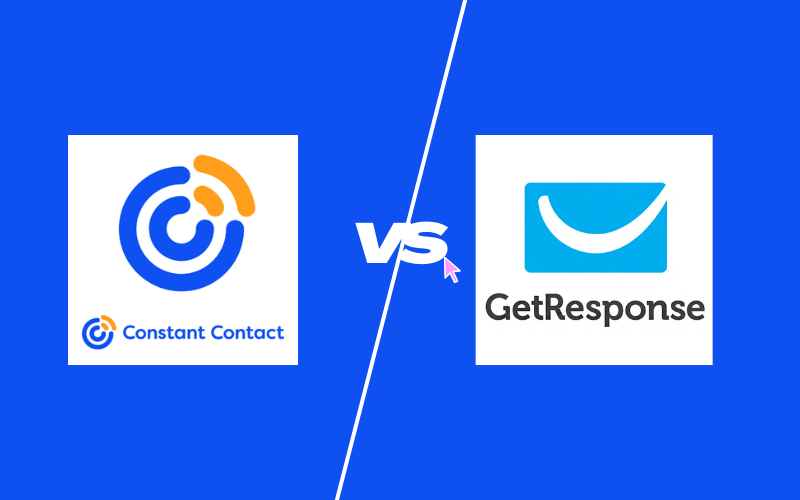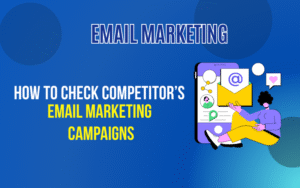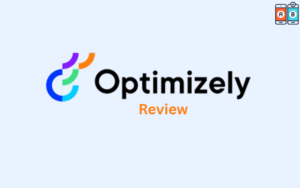Constant Contact vs GetResponse
Choosing the right email marketing platform can be a game-changer for your business. In this comparison of Constant Contact vs GetResponse, we’ll break down the key features, pricing, and overall performance of each platform to help you make an informed decision. Whether you’re just getting started or looking for more advanced tools, understanding the strengths and weaknesses of both platforms will guide you toward the best solution for your marketing needs.
Ease of Use
In a comparison of Constant Contact vs GetResponse, ease of use is a key factor—especially for beginners or small business owners who don’t have time to learn complex tools.
Constant Contact is known for its straightforward interface. The dashboard is clean, and creating an email campaign is quick thanks to the drag-and-drop editor. The platform also provides guided steps, which are helpful for users new to email marketing. Everything from contact management to scheduling emails is designed with simplicity in mind.
GetResponse, on the other hand, offers more advanced features, which can make the learning curve slightly steeper. However, its interface is still user-friendly, and there are tooltips and tutorials throughout the platform. Once you become familiar with the layout, creating automation workflows and landing pages becomes intuitive.
Which is easier to use?
If you’re looking for something simple and quick to set up, Constant Contact takes the lead. But if you’re willing to spend a bit more time learning the platform in exchange for more flexibility, GetResponse is a strong contender.
Pricing and Plans
When comparing Constant Contact vs GetResponse, pricing is a critical factor in choosing the right platform for your email marketing needs. Both offer tiered plans, but the features and costs vary significantly, depending on what you’re looking for.
Constant Contact offers two main pricing plans. The Lite plan starts at $12 per month and includes basic email marketing features like unlimited emails, email templates, list management, and basic reporting. The Standard Plan starts at $35 per month and includes all the features of the Lite plan, Standard advanced tools like email automation, A/B testing, and more advanced reporting.
For those who need more advanced features, Constant Contact also offers a Premium plan, but the pricing for this varies based on your contact list size and needs.

GetResponse offers a more flexible pricing structure with four plans. The Starter plan starts at $15 per month and includes core email marketing features, such as email templates, list management, and autoresponders. The Marketer plan, priced at $48 per month, includes everything in Basic, plus advanced automation, webinar hosting, and the ability to add 5 users. The Ecommerce plan starts at $97 per month and includes advanced segmentation, unlimited webinars, and marketing automation. The Max plan is custom-priced and offers enterprise-level features, including advanced reporting and dedicated support.
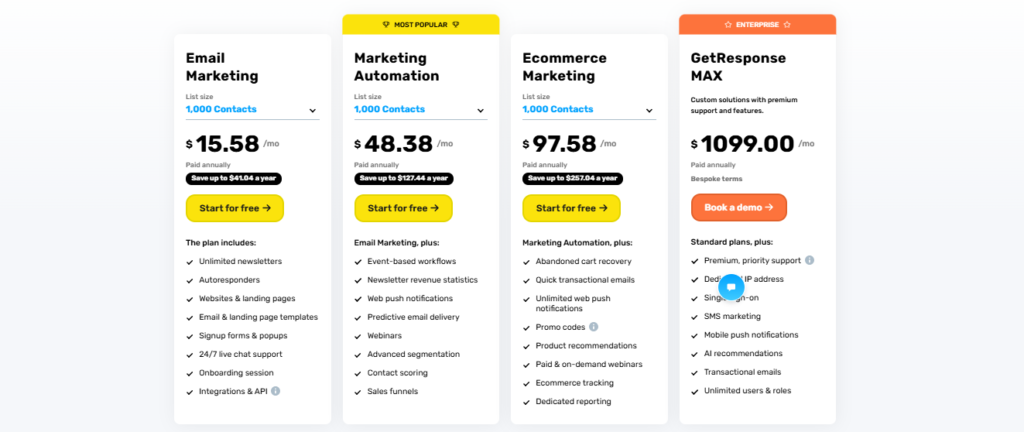
Which is more affordable?
If you’re just starting out and don’t need advanced features, Constant Contact may seem more affordable at its lower-tier price. However, GetResponse provides more value at its higher-tier plans, offering extra features like webinars and advanced automation that would cost more on Constant Contact.
Email Templates and Customization
When comparing Constant Contact vs GetResponse, the quality and customization of email templates play an essential role in crafting visually appealing and effective campaigns.
Constant Contact offers a wide variety of pre-designed email templates for different industries and campaign types, including newsletters, promotional emails, and event invitations. These templates are mobile-responsive and easy to customize, even for those with no design experience. The drag-and-drop editor makes it simple to add images, text, buttons, and other elements. For more advanced customization, users can tweak the HTML code, although this requires some coding knowledge.
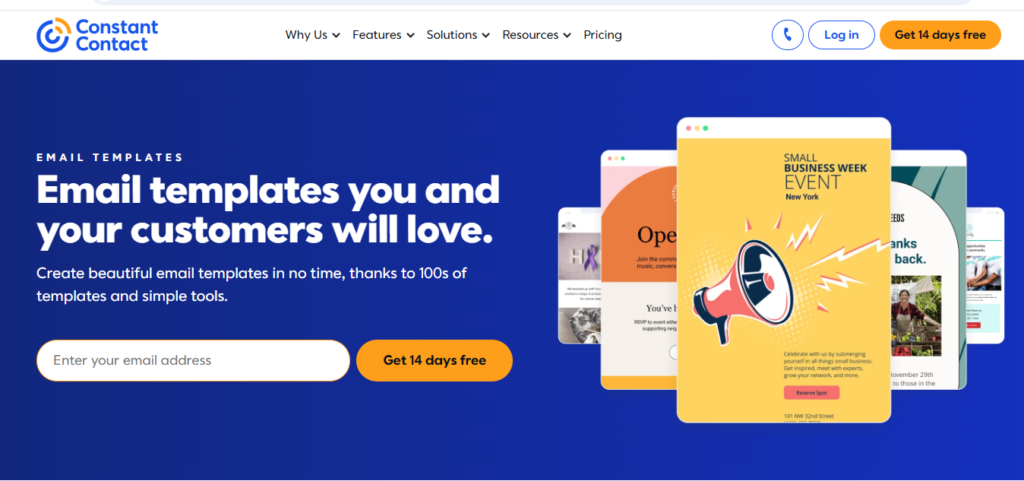
GetResponse also provides a rich library of email templates, covering various industries and use cases. The templates are designed to be mobile-friendly and can be easily customized using its drag-and-drop editor. What sets GetResponse apart is its AI-powered design tool, which can automatically generate templates based on your content. This tool helps speed up the design process, especially for beginners. Like Constant Contact, GetResponse also allows advanced customization through HTML editing.

Which is better for templates and customization?
Both platforms offer high-quality templates and easy customization. However, GetResponse has a slight edge with its AI-powered design tool, which can save time and help users design emails that look professional, even if they don’t have design experience. Constant Contact is a great option for users who prefer a more traditional approach and easy-to-use drag-and-drop functionality.
Marketing Automation
In a comparison of Constant Contact vs GetResponse, marketing automation is one of the most important factors to consider, especially for businesses looking to streamline their email marketing efforts.
Constant Contact offers solid automation features, including autoresponders that trigger emails based on user behavior or time delays. However, its automation options are somewhat basic compared to GetResponse. For instance, while Constant Contact allows you to set up welcome emails, birthday emails, and other simple workflows, it doesn’t offer much flexibility for creating more complex automation sequences.

GetResponse, on the other hand, excels in marketing automation. It provides a more advanced set of tools, including a visual workflow builder that allows you to create sophisticated automation sequences with multiple triggers, conditions, and actions. This feature is especially useful for businesses that want to deliver highly personalized and targeted campaigns. GetResponse also includes features like lead scoring, dynamic content, and behavioral-based automation, making it a more robust choice for users looking for advanced automation capabilities.
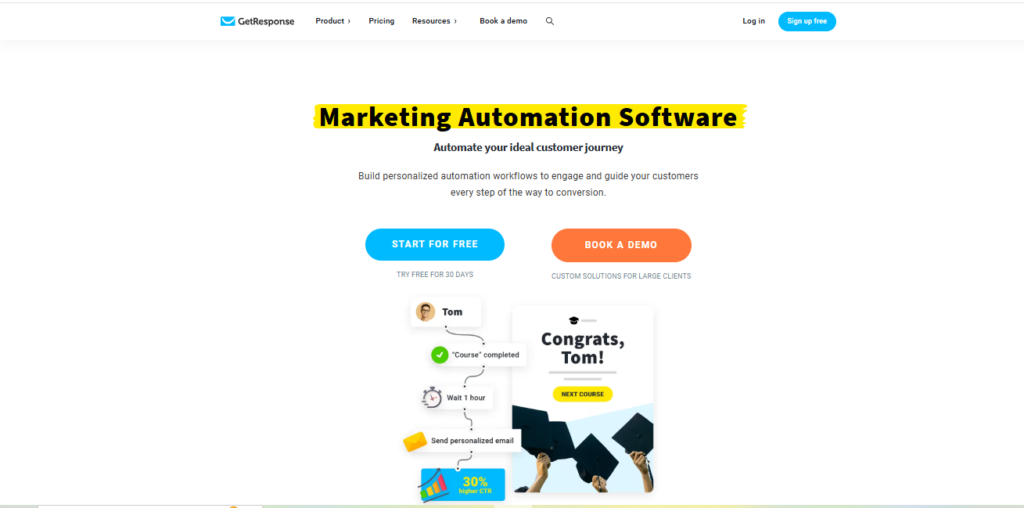
Which platform offers better automation?
For businesses that need simple automation and ease of use, Constant Contact is a good option. However, if you’re looking for more powerful, customizable, and flexible automation tools, GetResponse stands out as the better choice.
A/B Testing and Optimization
When comparing Constant Contact vs GetResponse, A/B testing and optimization are crucial features for improving email campaign performance and ensuring that your marketing efforts deliver the best results.
Constant Contact offers basic A/B testing capabilities, allowing you to test different subject lines, send times, and content variations. However, it is somewhat limited in comparison to GetResponse. The platform provides a straightforward approach, making it easy for beginners to set up tests, but it lacks more advanced optimization features that can help refine campaigns over time.
GetResponse, on the other hand, provides more advanced A/B testing tools. It allows you to test not only subject lines and content but also different send times, email layouts, and even the entire email workflow. Additionally, GetResponse includes a feature called Smart Targeting, which optimizes content based on customer behavior and preferences. This level of automation allows for more effective and dynamic testing, helping to improve engagement rates and conversions.
Which platform is better for A/B testing and optimization?
While Constant Contact is a solid choice for simple A/B testing, GetResponse stands out with its comprehensive optimization tools. For those looking for more control and advanced testing capabilities, GetResponse is the better option.
Integrations and Compatibility
In comparing Constant Contact vs GetResponse, integrations and compatibility with other tools are essential factors to consider, especially for businesses that use various platforms to manage their marketing, CRM, or e-commerce.
Constant Contact offers a wide range of integrations with third-party apps, including popular platforms like WordPress, Shopify, Salesforce, and Google Analytics. Its integration options are designed to work well for small to medium-sized businesses looking for a straightforward approach to syncing their email marketing with other software. While Constant Contact supports essential integrations, it does not offer as many advanced or niche integrations as GetResponse.
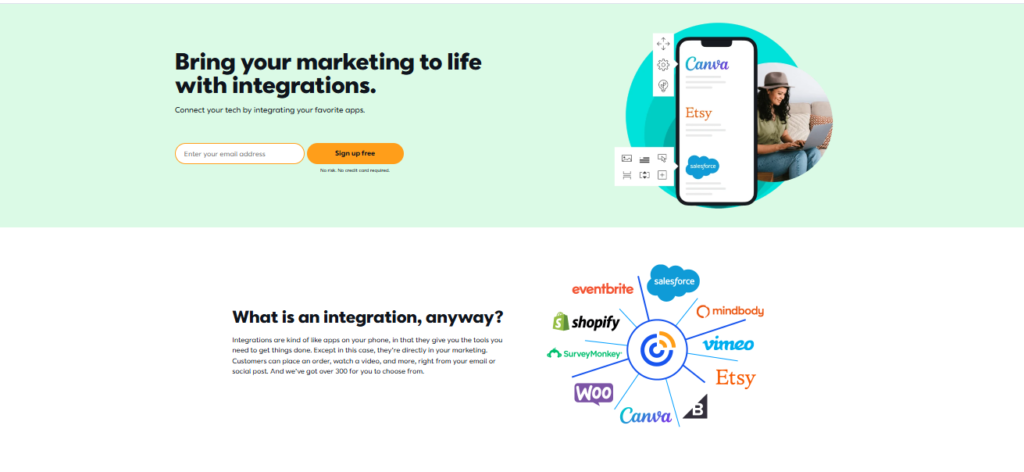
GetResponse provides a broader selection of integrations, supporting major e-commerce, CRM, and social media platforms. It seamlessly integrates with tools like Shopify, WooCommerce, Magento, PayPal, and Salesforce. Additionally, GetResponse has an open API, allowing for custom integrations, which is particularly useful for larger businesses or those with specific software needs. GetResponse also offers integrations with popular webinar platforms, making it an excellent choice for users looking to run webinars alongside their email marketing campaigns.

Which platform offers better integrations?
If you’re looking for essential integrations with popular tools and platforms, Constant Contact does a solid job. However, if you require more extensive integrations, particularly for e-commerce or custom workflows, GetResponse offers more options and flexibility.
Customer Support and Resources
In the comparison of Constant Contact vs GetResponse, customer support and available resources are crucial for ensuring that users can resolve issues quickly and get the most out of their email marketing platform.
Constant Contact provides a variety of support options, including phone support, live chat, and an extensive help center. The platform also offers a wide range of resources, such as video tutorials, email marketing guides, and live webinars. The customer support team is known for being responsive and helpful, particularly for beginners who need extra assistance. However, some users have reported that the phone support wait times can be longer during peak hours.
GetResponse also offers excellent customer support, including 24/7 live chat and email support. For more in-depth issues, users can access phone support. Additionally, GetResponse has a vast knowledge base with video tutorials, blog posts, webinars, and a comprehensive FAQ section. It also offers live chat support for all plan tiers, which is a key advantage for businesses that require constant assistance. GetResponse provides an advanced customer support feature called “GetResponse Academy,” offering training on email marketing, automation, and more.
Which platform offers better customer support?
Both platforms provide solid customer support, but GetResponse has the edge with its 24/7 live chat, GetResponse Academy, and more extensive learning resources. Constant Contact is great for beginner-level support but may have longer wait times for phone support.
Pros and Cons
When deciding between Constant Contact vs GetResponse, it’s essential to weigh the strengths and weaknesses of each platform to determine which best fits your needs.
Pros of Constant Contact
- User-Friendly Interface: Constant Contact is known for its simple and intuitive interface, making it a great choice for beginners.
- Reliable Customer Support: With phone support, live chat, and a robust knowledge base, users can quickly get assistance when needed.
- Solid Email Templates: Constant Contact offers a variety of customizable email templates, which help create professional-looking emails without needing design skills.
- Event Management Tools: Unique to Constant Contact, the event management tools make it easy to promote and manage events directly from the platform.
Cons of Constant Contact
- Limited Automation Features: Compared to GetResponse, Constant Contact’s automation options are basic and may not meet the needs of businesses seeking advanced workflow customization.
- Pricing: Constant Contact tends to be more expensive for smaller businesses, especially when considering the limited features on the lower-tier plans.
- Fewer Integrations: Constant Contact offers fewer integrations with third-party apps compared to GetResponse, which could limit users who rely on specific tools.
Pros of GetResponse
- Advanced Automation: GetResponse offers advanced automation features, including the visual workflow builder, lead scoring, and behavioral triggers, making it ideal for businesses with complex marketing needs.
- Better Value for Money: GetResponse provides more comprehensive features at a competitive price, offering advanced tools even on lower-tier plans.
- Webinar Integration: GetResponse includes webinar hosting as part of its platform, which is a standout feature for businesses looking to run webinars alongside email marketing campaigns.
- Extensive Integrations: With a wide range of integrations, including an open API, GetResponse is a great choice for businesses needing flexibility and customization.
Cons of GetResponse
- Steeper Learning Curve: The platform’s advanced features and extensive tools can be overwhelming for beginners who may need more time to get accustomed to the platform.
- Limited Phone Support: While GetResponse offers 24/7 live chat, phone support is only available for higher-tier plans, which might be a limitation for users on basic plans.
Which platform is better for you?
Both Constant Contact and GetResponse have their strengths. If you’re a small business or a beginner looking for an easy-to-use platform with reliable customer support, Constant Contact could be the right choice. However, if you’re seeking advanced automation, a wider range of features, and better value for money, GetResponse stands out as the better option.
Conclusion
In the battle of Constant Contact vs GetResponse, both platforms offer solid features that cater to different needs and business sizes. Constant Contact excels in simplicity and ease of use, making it ideal for small businesses and beginners who want an intuitive email marketing solution. Its solid customer support, reliable email templates, and event management tools are great advantages for users seeking a straightforward platform.
On the other hand, GetResponse offers more advanced features, including powerful automation, a visual workflow builder, and better value for money. If you’re looking for a comprehensive solution that includes features like webinar hosting and extensive integrations, GetResponse is the superior choice, especially for businesses with more complex marketing needs.
Ultimately, the decision between Constant Contact vs GetResponse depends on your specific requirements. If simplicity and ease of use are your top priorities, Constant Contact is a great fit. However, if you need more advanced marketing tools, better automation capabilities, and a broader selection of integrations, GetResponse is the better choice.
Take the time to assess your business needs, and choose the platform that aligns with your goals for effective and efficient email marketing.

